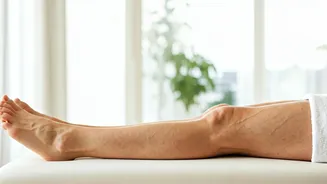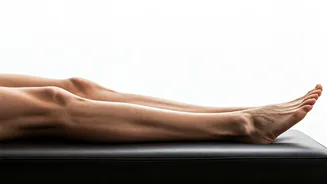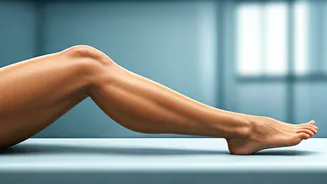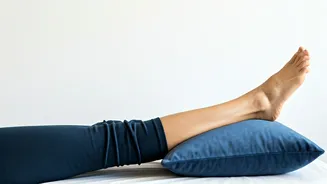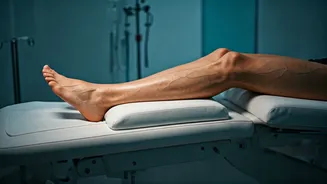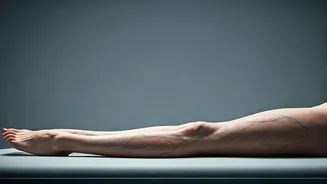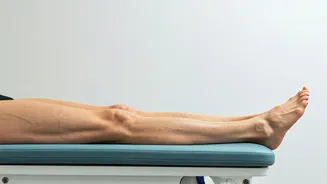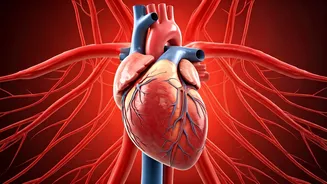Circulation Savior
Leg elevation is essentially raising your legs above your heart while lying down. This practice, often recommended for just 10 minutes a day, has significant
effects on circulation. Elevating your legs helps reduce the pooling of blood in your lower extremities, a common cause of swelling and discomfort. This can be especially beneficial for those who sit or stand for extended periods. When the legs are raised, gravity assists the blood's return to the heart, decreasing pressure in the veins. This, in turn, boosts overall circulation. Regular leg elevation may also help reduce the risk of varicose veins and blood clots, contributing to healthier legs and a more efficient circulatory system. It is a simple, effective method to improve blood flow, promoting better health.
Swelling & Edema Relief
One of the most immediate benefits of leg elevation is its ability to reduce swelling, particularly in the ankles and feet. Edema, or fluid buildup in the lower legs, often results from extended periods of inactivity, heat, or certain medical conditions. Elevating the legs helps drain this excess fluid, reducing puffiness and discomfort. The simple act of leg elevation allows gravity to assist in drawing the fluid back into the circulatory system, where it can be processed and eliminated by the body. Many individuals report noticeable relief after just a few minutes of leg elevation, feeling less tightness and improved mobility. This gentle technique provides a natural and non-invasive way to manage edema, enhancing comfort and overall well-being. It is a practical solution for daily swelling and a valuable addition to your health routine.
Vein Health Boost
Beyond immediate relief, leg elevation can play a vital role in long-term vein health. Prolonged standing or sitting can put pressure on the veins in your legs, potentially leading to conditions such as varicose veins. These swollen, twisted veins can be both unsightly and uncomfortable. Leg elevation alleviates this pressure by assisting blood flow back to the heart. By regularly practicing this simple exercise, you can decrease the likelihood of developing these issues. For those already experiencing vein problems, leg elevation can also provide some symptom relief. Improved circulation strengthens the veins and reduces the risk of blood pooling, contributing to overall vascular health. Implementing this into a daily routine provides both immediate comfort and promotes long-term vein health.
Muscle Relaxation Benefit
Another notable advantage of leg elevation is muscle relaxation. Elevating your legs eases tension and strain on the leg muscles, which are often overworked during the day. This is especially true for those who engage in physical activity or spend a lot of time on their feet. Relaxing the leg muscles can provide a soothing effect, promoting muscle recovery and reducing the likelihood of cramps or spasms. By providing a break from the constant pull of gravity, leg elevation allows the muscles to fully relax. This relaxation contributes to a greater sense of well-being. Incorporating leg elevation into your routine is a simple, yet effective way to support muscle health.
Daily Routine Integration
Adding leg elevation to your daily routine is incredibly simple. All you need is a comfortable place to lie down and something to prop your legs on, such as pillows or cushions. Aim to elevate your legs above your heart for about 10 minutes each day. This can be done at any time that suits your schedule: before bed, during a break from work, or while watching television. Consistency is key, so make it a habit. Start slowly and gradually increase the duration as you feel comfortable. Even a few minutes a day can yield noticeable benefits. You will find that this practice contributes to a greater sense of well-being and aids in better circulation. Simple, accessible, and highly beneficial, leg elevation is easily incorporated into any lifestyle.
Addressing Potential Concerns
While leg elevation is generally safe for most people, some individuals should take precautions. Those with certain medical conditions, such as deep vein thrombosis or severe heart problems, should consult their doctor before starting this practice. Additionally, individuals with any discomfort or pain in their legs should stop and seek medical advice. It is also important to note that leg elevation is not a cure-all, and it should not be considered a substitute for proper medical care. However, it can be a valuable supplement to your overall health routine. Always listen to your body and adjust the practice as needed. By being aware of your individual health needs and consulting with healthcare professionals when necessary, you can enjoy the many benefits of leg elevation safely and effectively.
